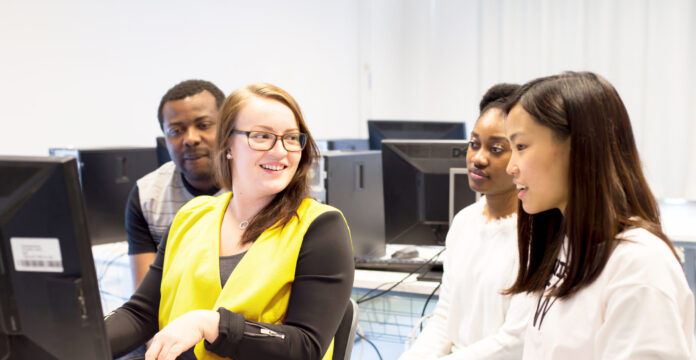Vaasa University Diversity Management Course has evolved to what it is today from a book based exam course after series of revisions in the course contents and teaching methods. Within a time span of some seven years this course in focus has evolved from a book and article based exam course into a lively experience based course. The course implementation has taken it through several different implementation forms. Originally, in the start of this observation period of six years the course consisted of a variety of books and article materials. There were no lectures, and the participant took part of an exam at a time point of his/her choice. The course made a total metamorphosis from here to a fully network based course. The next phase in the development took a few steps backward, and the course was implemented in a multi-form model consisting of a network structure supported by a few on-site meetings and lectures. The amount of these physical meetings was limited. This implementation form evolved into a complex multi-site (two different places), multiple participant group (university and open university students), and multi-language (Finnish, English) format. Integrating all these various elements simultaneously was to say the least a challenging endeavor. The present version of the course implementation consists of a broad digital emphasis supported by strong classroom participation demanding format.
The course is intended for master degree students pursuing International business, Strategic management, Human resource management and exchange students from the faculty of business studies. As the core idea of this course is about diversity the teachers of the course also represent diversity. We have considered it valuable that the teachers Risto Säntti & S.Narashima Boopathi represent different nationality, religion, ethnicity, educational level, generation etc. Therefore, the background of the teachers has been instrumental in developing this course in to a meaningful experience. The course is blend with both solid theory and as well as application from practice. By attending the course students will feel the difference of diverse experiences. Diversity is the core of the curriculum as the course will consists of participants from different background such as age, gender, ethnicity, religion etc. and also the topic is sensitive therefore, high importance is given to integrate all these aspects in mind. How to handle important topics that need to be approached but may be sensitive for different course participant related reasons. The course is planned in a way that makes it possible for participants to approach their beliefs, keeping in mind that beliefs sometimes need to be reevaluated in diverse organizational realities. A wide range of tasks and elements are integrated into the course to provide an interesting, challenging and sometimes belief shaking experience to the students.
Taking in to consideration of the diversity of the student’s background this course has adapted several advancement in teaching and curriculum development of this course which will be explained below.
ASSESSMENT
The assessment criteria are divided in to two parts: individual work 50% and group work will be remaining 50%. As the student group is mixed of people from different background and keeping that in mind the assessment criteria is developed in such a way that all of the students can show their abilities in the course. For instance some students will be good in individual task and some will be in group work however as a teacher it is our responsibility to fulfill the needs of all the students and their background in mind. Therefore the assessment will be like Pre-course assignment 20%, Group work 25%, Drama Group Work 25%, and Final assignment 30%. So by this assessment method students can show their individual capabilities as well as their group working capabilities. The course don’t have any exam as it is substituted by the individual assignment.
STUDENT-CENTEREDNESS, COLLABORATION AND STUDENTS’ SELF-ASSESSMENT
The course is developed in such a way which combines the student-centeredness, collaboration and self-assessment. For instance the student is given a pre-course assignment which is an individual task where they are supposed to write their personal experience about Diversity. In a way this task is given to bring out the experience of students by assessing themselves. Four questions are dedicated to bring out the self-assessment of the students. Moreover, we also have course activities such as drama and debate where the students are more actively involved which is more of student centeredness. Also to increase the collaboration among the students the students are given two group work where they will be working in different groups. The students are also encouraged to be participative during the lectures. The course also contains some spontaneous group tasks which are also targeted to encourage the collaboration of students from different background. As this course is about diversity to increase the collaboration of students we try to change the students in different groups by which more and more understanding will happen between them.
DRAMA AS A METHOD OF TEACHING
The business world is becoming increasingly global and it is important for students to be relevant in this changing facet. In this scenario it is important to introduce new ways of teaching to the students to face the global business world. Therefore, drama approach is being used as one of the teaching method in the Diversity Management course. The reason for using drama approach is that it enables the students to experience the real life situations and challenges that take place in organizations consisting of people from diverse backgrounds. Drama is a potential way to make issues of human interaction visible and experienced. Drama brings along feelings in addition to cognitive and conative elements of an organizational setting. In this sense experience build strong memories and thereby supports effective learning. In the final debate exercise the group of participants is divided into two groups. A topic for the debate groups is provided on which the two groups debate for and against. Before the debate the groups are supposed to discuss within with their colleagues and collect information needed for optimal performance. Debate enables the participants to discuss the topic in detail through which the students will get several viewpoints. This act is then to be evaluated or commented by other groups. After the comments the participants are supposed to act and react by altering the situation. The idea is not to give right answers but to help find right questions.
DEBATE
Debate is a new teaching method introduced from the year 2014. The group of participants are divided in to two groups and are assigned a topic on diversity management. The participants are supposed to debate for and against the topic assigned. The debate is moderated by the teacher (Risto Säntti) who will be giving the comments during the topic. The debate is watched by the students who are not participating as a debate group, instead they are assigned the role as the spectators. Besides, during the debate the spectators are also assigned to raise questions, comment and discuss in the debate. In this spring 2015 external participants will also be invited to be a part of the debate. A plan is being made to project the debate outside the auditorium in the net and on university information system. Our intention is that through this debate we would like to open up the discussion on diversity which will enable them to understand, and experience different views on diversity. By debating the issues related to diversity the students are able to critically think on diversity at the same time also develop the open mindedness.
RESEARCH
From the year 2013 Diversity Management course implementation we started doing research on the assignment of the students to find out how the students perceive, experience and understand the diversity phenomenon. The students were given pre-assignment before the starting of the course to reflect on their experience about diversity. The purpose of this assignment to bring out the experience of diversity from the students from their own life experiences. So we decided to focus on their understanding derived from their own life experiences. Thereby the diversity focused research was initiated from the student’s assignment material. In a way this assignment helped us to understand what students view as diversity most and what is not recognized by them. So far we have been working on the student’s assignment from the year 2013 & 2014. Approximately 85 student’s assignments were taken in to consideration for the purpose of research. The student assignment from the current year 2015 will also be considered for the purpose of research. By end of this year we are planning to send our research article to the journal. In the year 2013 our research findings were presented at Oxford Educational Research Symposium.
VIDEO AND OTHER EDUCATIONAL TECHNOLOGY
Virtual environment and virtual learning technology are an integral part of the Diversity Management course. Short videos made especially for this course are used as introductory material for pre-course task, as well as within the course lectures. In addition to those self-made tailored videos a considerable amount of diversity topic opening publicly available video materials have been utilized. These are to encourage students to be innovative and to utilize tools like short films, video assignments, Prezi, Thing Link in order to present their group works assignments. Moodle platform has formed the base for teaching, material distribution, off-site discussions etc. Naturally more traditional forms of academic literatures on diversity are an integral part of course materials..
TEACHING PRACTICE
The Diversity Management course is also utilized as a part of pedagogical studies for S.Narashima Boopathi, who is one of the teachers in this course. Boopathi’s pedagogical practice will be done in the spring 2015 Diversity Management course.
S.Narashima Boopathi & Risto Säntti 10.4.2015

